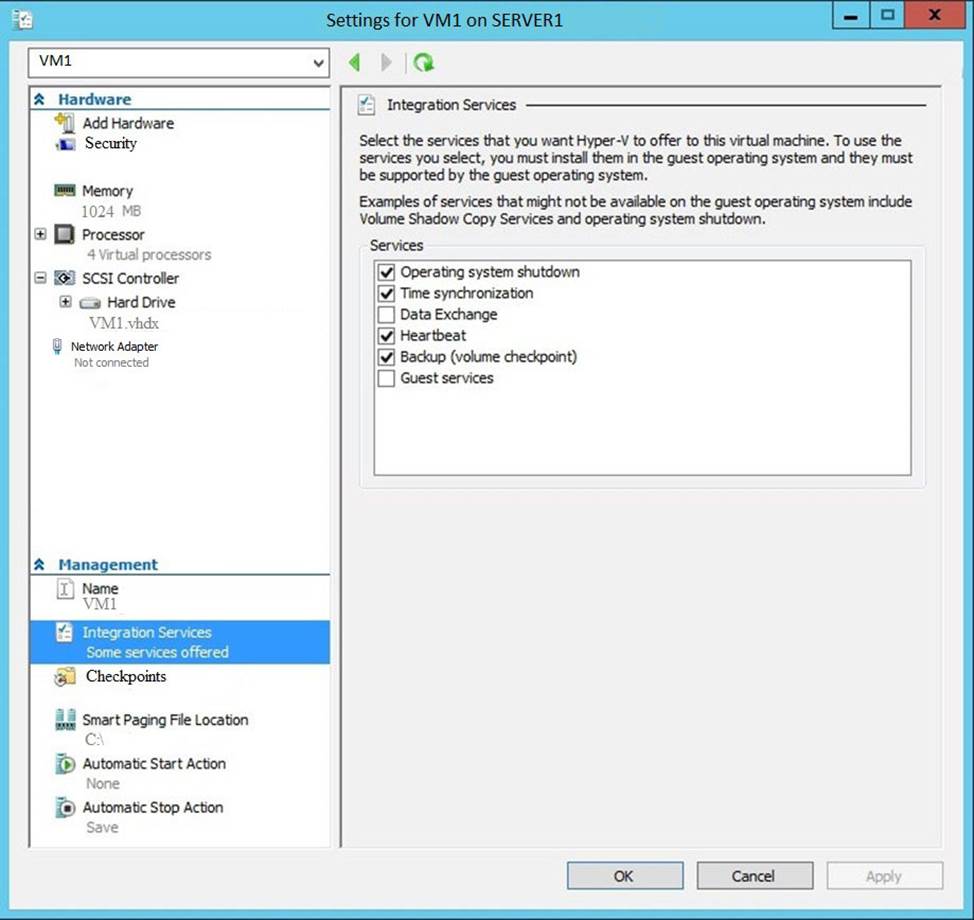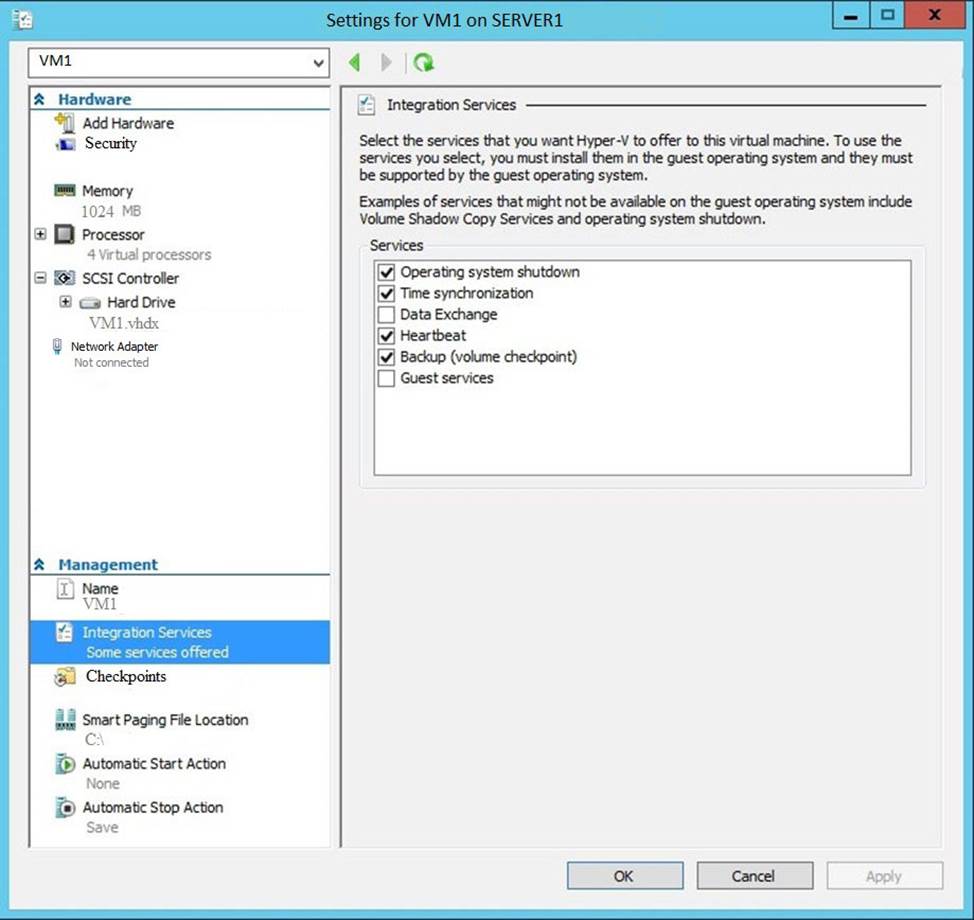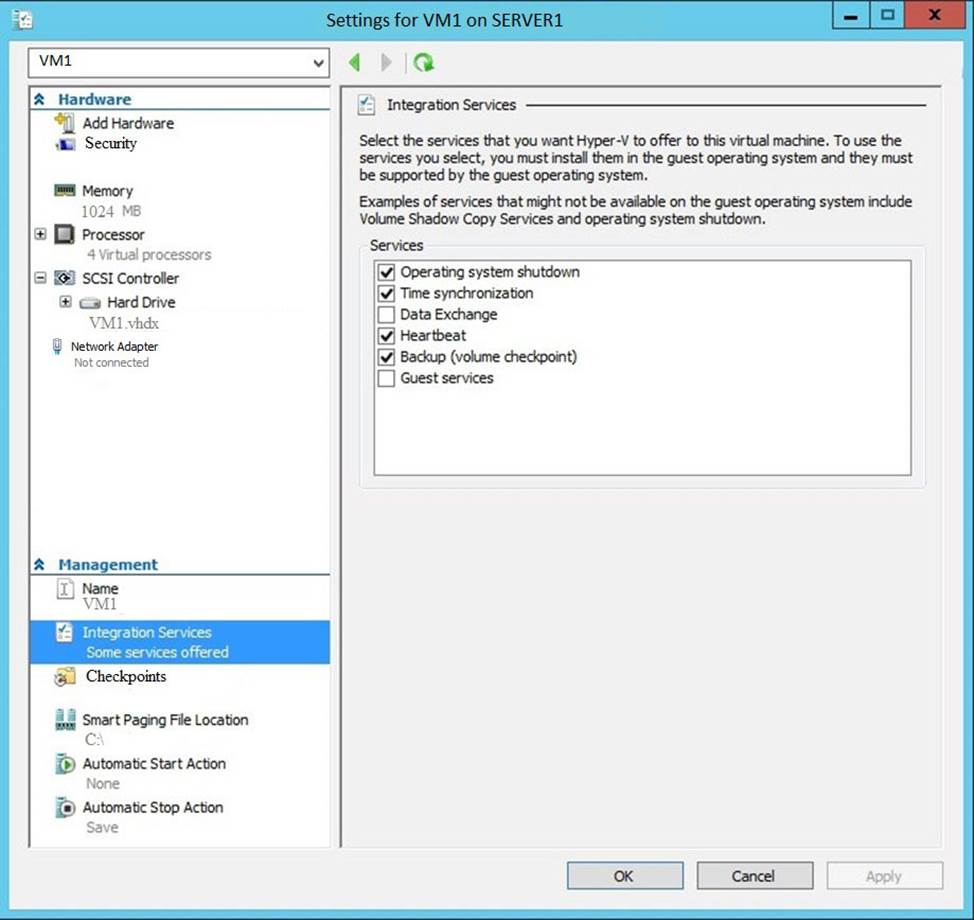Microsoft 70-741 Networking with Windows Server 2016 Online Training
Microsoft 70-741 Online Training
The questions for 70-741 were last updated at Jan 03,2026.
- Exam Code: 70-741
- Exam Name: Networking with Windows Server 2016
- Certification Provider: Microsoft
- Latest update: Jan 03,2026
Your network contains an Active directory forest named contoso.com. The forest has a Distributed File System (DFS) namespace named \contoso.comnamespace1.
The domain contains a file server named Server1 that runs Windows Server 2016.
You create a folder named Folder1 on Server1.
You need to use Folder1 as a target for Namespace1.
Which two cmdlets should you use? Each correct answer presents part of the solution.
NOTE: Each correct selection is worth one point.
- A . New-DfsnFolderTarget
- B . Install-WindowsFeature
- C . Grant-DfsnAccess
- D . New-DfsnFolder
- E . New-SmbShare
Note: This question is part of a series of questions that use the same or similar answer choices. An answer choice may be correct for more than one question in the series. Each question is independent of the other questions in this series. Information and details provided in a question apply only to that question.
Your network contains Windows and non-Windows devices.
You have a DHCP server named Server1 that has an IPv4 scope named Scope1.
You need to prevent a client computer that uses the same name as an existing registration from updating the registration.
What should you do?
- A . From the properties of Scope1, modify the Conflict detection attempts setting.
- B . From the properties of Scope1, configure Name Protection.
- C . From the properties of IPv4, configure the bindings.
- D . From IPv4, create a new filter.
- E . From the properties of Scope1, create an exclusion range.
- F . From IPv4 run the DHCP Policy Configuration Wizard.
- G . From Control Panel, modify the properties of Ethernet.
- H . From Scope1, create a reservation.
Note: This question is part of a series of questions that present the same scenario. Each question in the series contains a unique solution that might meet the stated goals. Some question sets might have more than one correct solution, while others might not have a correct solution.
After you answer a question in this sections, you will NOT be able to return to it. As a result, these questions will not appear in the review screen.
Your network contains an Active Directory domain named contoso.com
You need to create a Nano Server image named Nano1 that will be used as a virtualization host. The windows server 2016 source files are located in drive D.
Solution: You run the following cmdlet.
New-NanoServerImage CEdition Datacenter CDeploymentType Host CPackage MicrosoftNanoServerSCVMM-Package CMediaPath ‘D: -TargetPath C:nano1Nano1.wim
CComputerName Nano1 C Domainname Contoso.com
Does this meet the goal?
- A . Yes
- B . NO
Note: This question is part of a series of questions that present the same scenario. Each question in the series contains a unique solution that might meet the stated goals. Some question sets might have more than one correct solution, while others might not have a correct solution.
After you answer a question in this sections, you will NOT be able to return to it. As a result, these questions will not appear in the review screen.
Your network contains an Active Directory domain named contoso.com
You need to create a Nano Server image named Nano1 that will be used as a virtualization host. The windows server 2016 source files are located in drive D.
Solution: You run the following cmdlet.
New-NanoServerImage -Edition Datacenter -DeploymentType Host -Package Microsoft-NanoServerCompute-Package -MediaPath ‘D:’ -TargetPath C:Nano1Nano1.wim -ComputerName Nano1 -DomainName Contoso.com
Does this meet the goal?
- A . Yes
- B . NO
Note: This question is part of a series of questions that present the same scenario. Each question in the series contains a unique solution that might meet the stated goals. Some question sets might have more than one correct solution, while others might not have a correct solution.
After you answer a question in this sections, you will NOT be able to return to it. As a result, these questions will not appear in the review screen.
Your network contains an Active Directory domain named contoso.com
You need to create a Nano Server image named Nano1 that will be used as a virtualization host. The windows server 2016 source files are located in drive D.
Solution: You run the following cmdlet.
New-NanoServerImage -Edition Datacenter -DeploymentType Host -Compute
-Media ‘D:’ -TargetPath c:Nano1Nano1.wim -ComputerName Nano1 -DomainName Contoso.com
Does this meet the goal?
- A . Yes
- B . NO
Note: This question is part of a series of questions that present the same scenario. Each question in the series contains a unique solution that might meet the stated goals. Some question sets might have more than one correct solution, while others might not have a correct solution.
After you answer a question in this sections, you will NOT be able to return to it. As a result, these questions will not appear in the review screen.
You have a Hyper-V host named Server1 that hosts a virtual machine named VM1. Server1 and VM1 run Windows Server 2016.
The settings for VM1 are configured as shown in the exhibit below.

You need to ensure that you can use the Copy-VMFile cmdlet on Server1 to copy files from VM1.
Solution: You need to enable the Data Exchange integration service for VM1.
Does this meet the goal?
- A . YES
- B . NO
Note: This question is part of a series of questions that present the same scenario. Each question in the series contains a unique solution that might meet the stated goals. Some question sets might have more than one correct solution, while others might not have a correct solution.
After you answer a question in this sections, you will NOT be able to return to it. As a result, these questions will not appear in the review screen.
You have a Hyper-V host named Server1 that hosts a virtual machine named VM1. Server1 and VM1 run Windows Server 2016.
The settings for VM1 are configured as shown in the exhibit below.

You need to ensure that you can use the Copy-VMFile cmdlet on Server1 to copy files from VM1.
Solution: You need to enable the Guest Service integration service for VM1.
Does this meet the goal?
- A . YES
- B . NO
Note: This question is part of a series of questions that present the same scenario. Each question in the series contains a unique solution that might meet the stated goals. Some question sets might have more than one correct solution, while others might not have a correct solution.
After you answer a question in this sections, you will NOT be able to return to it. As a result, these questions will not appear in the review screen.
You have a Hyper-V host named Server1 that hosts a virtual machine named VM1. Server1 and VM1 run Windows Server 2016.
The settings for VM1 are configured as shown in the exhibit below.

You need to ensure that you can use the Copy-VMFile cmdlet on Server1 to copy files from VM1.
Solution: You start the Hyper-V Guest Service Interface service on VM1.
Does this meet the goal?
- A . YES
- B . NO
You have two Hyper-V hosts named Server1 and Server2 that run windows server 2012 R2. The servers are nodes in a failover cluster named Cluster1.
You perform a rolling upgrade of the cluster nodes to Windows Server 2016.
You need to ensure that you can implement the Virtual Machine Load Balancing feature.
Which cmdlet should you use?
- A . Update-ClusterFunctionalLevel
- B . SetCauClusterRole
- C . Update-ClusterNetWorkNameResource
- D . Set-ClusterGroupSet
You have a Scale-Out File Server that has a share named Share1. Share1 contains a virtual disk file named Disk1.vhd.
You plan to create a guest failover cluster.
You need to ensure that you can use the virtual disk as a shared virtual disk for the gust failover cluster.
Which cmdlet should you use?
- A . Optimize VHD
- B . Optimize VHDSet
- C . Convert-VHD
- D . Set-VHD
Latest 70-741 Dumps Valid Version with 259 Q&As
Latest And Valid Q&A | Instant Download | Once Fail, Full Refund


Thanks
thx